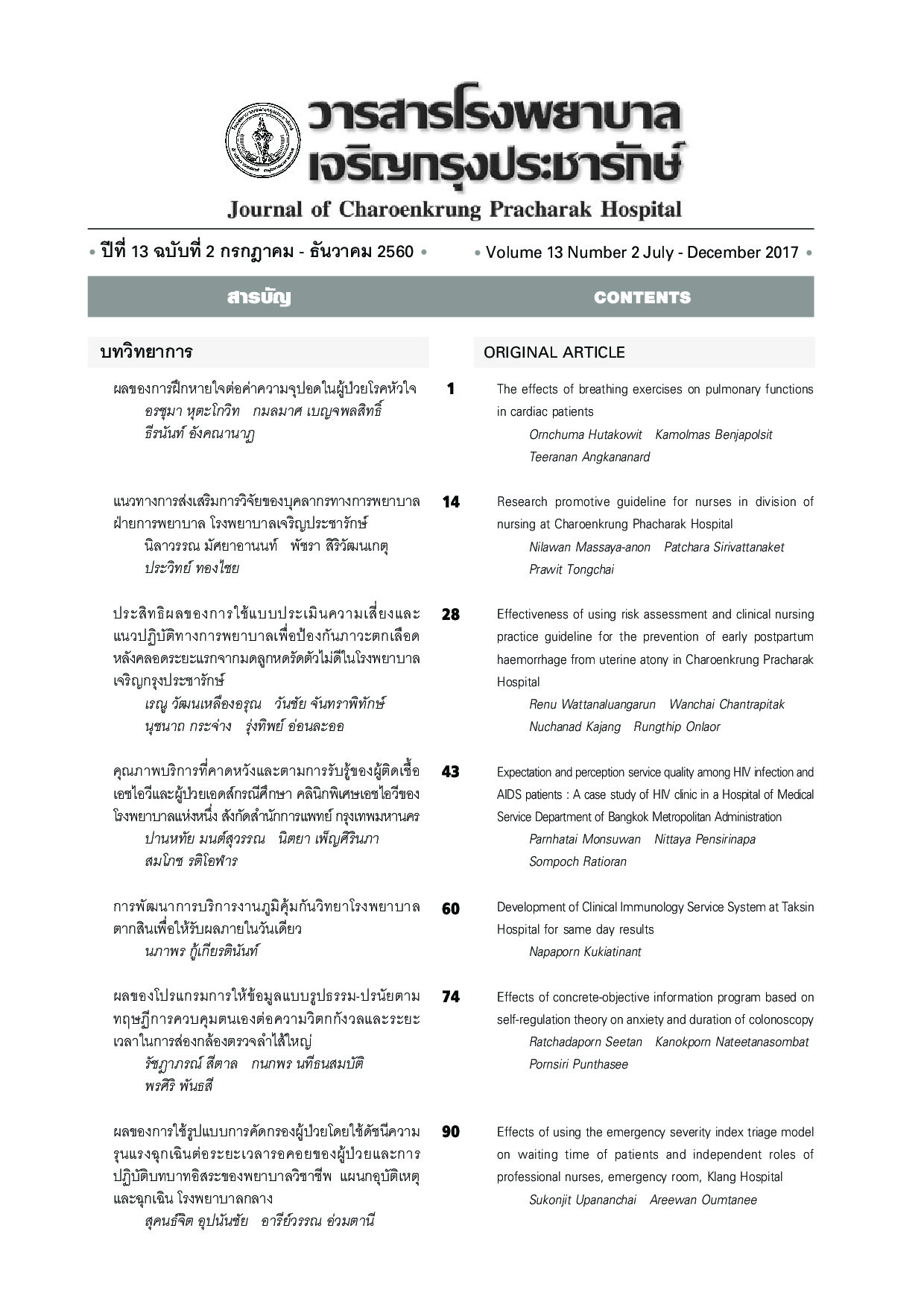| |
References
1. อัมภา ศรารัชต์, จินนะรัตน์ ศรีภัทรภิญโญ และอมรรัตน์ อนุวัฒ์ นนทเขตท์. การจำแนกประเภทผู้ป่วย
งานบริการพยาบาลผู้ป่วยใน. กรุงเทพ. 2547; 9-14.
2. Christ M, Grossmann F, Winter D, Bingisser R, Platz E. Modern Triage in the Emergency
Department. Dtsch Arztebl Int. 2010; 107(50): 892-902.
3. สถาบันการแพทย์ฉุกเฉินแห่งชาติ. เกณฑ์การคัดแยกผู้ป่วยฉุกเฉินและจัดลำดับการบริบาล ณ ห้อง
ฉุกเฉินตามหลักเกณฑ์ที่ กพฉ. กำหนด (ฉบับที่ 1) พ.ศ. 2556. กรุงเทพ: สถาบันการแพทย์ฉุกเฉินแห่งชาติ.
2547; 3-4.
4. Gilboy N, Tanabe P, Travers D, Rosenau AM. Emergency Severity Index (ESI): A Triage Tool
for Emergency Department Care, Version 4. Implementation Handbook 2012 Edition. AHRQ
Publication No.12-0014. Rockville, MD. Agency for Healthcare Research and Quality. 2011.
5. จันทรา จินดา. ผลของการใช้รูปแบบการคัดกรองผู้ป่วยตามระดับความเร่งด่วน ต่อความพึงพอใจของ
ผู้ใช้บริการและความพึงพอใจในงาน ของพยาบาลหน่วยงานอุบัติเหตุและฉุกเฉิน วิทยาลัยแพทยศาสตร์
กรุงเทพมหานครและวชิรพยาบาล. [วิทยานิพนธ์ปริญญามหาบัณฑิต สาขาวิชาการบริหารการพยาบาล].
กรุงเทพฯ: จุฬาลงกรณ์มหาวิทยาลัย; 2546.
6. Chan TC, Killeen JP, Kelly D, Guss DA. Impact of Rapid Entry and Accelerated Care at
Triage on Reducing Emergency Department Patient Wait Times, Lengths of Stay and Rate of Left
Without Being Seen. Ann Emerg Med. 2005; 46 (6): 491-7.
7. กงทอง ไพศาล. การพัฒนาเครื่องมือจำแนกประเภทผู้ป่วย งานอุบัติเหตุและฉุกเฉิน โรงพยาบาลพล
จังหวัดขอนแก่น. วารสารพยาบาลศาสตร์และสุขภาพ. 2554; 34 (3): 57-64.
8. Croskerry P, Cosby KS, Schenkel SM, Wears RL. Patient Safety in Emergency Medicine.
U.S.A: Lippincott Williams & Wilkins. 2009.
9. Emergency Excellence. Intuitive and rapid emergency department intake increases safety. 2010.
Available at http://www.emergencyexcellence.com/newsletter/march _2010.htm. Retrieved Dec 15, 2014.
10. Pennsynvania Patient Safety Advisory. Managing Patient Access and Flow in the Emergency
Department to Improve Patient Safety. Pennsynvania Patient Safety Advisory. 2010; 7 (4): 123-34.
11. Gerdtz MF, Bucknall TK. Why we do the things we do: applying clinical decision making
frameworks to triage practice. Dtsch Arztebl Int. 1999; 7: 50-7.
12. สุมาลี จักรไพศาล, ชฎาภรณ์ เปรมปรามอมร, ณัฐนันท์ มาลา. ผลของการคัดกรองผู้ป่วยโดยใช้ดัชนี
ความรุนแรงฉุกเฉินสระบุรีต่อความสอดคล้องของการจำแนกระดับความรุนแรงของผู้ป่วย ระยะเวลารอ
คอยแพทย์ตรวจ ความพึงพอใจของผู้ใช้บริการและความพึงพอใจในงานของพยาบาล หน่วยงาน
อุบัติเหตุฉุกเฉิน โรงพยาบาลสระบุรี. 2557. [เข้าถึงเมื่อ 2558 กุมภาพันธ์ 10]. เข้าถึงได้จาก
http://www. niems.go.th/main/upload/file/ 20110405024108.pdf
13. Chung JYM. Exploration of accident and emergency nurse experiences of triage decision making in
Hong Kong. Accid Emerg Nurs. 2005; 13: 206-13.
14. Jelinek L, Fahje C, Immermann C, Elsbernd T. The trauma report nurse: A trauma triage
process improvement project. Int Emerg Nurs. 2014; 40 (5): 111-7.
15. Maas M, Jacox AK. Guideline for nurse autonomy / patient welfare. New York: Appleton-
Century-Crofts. 1977.
16. Singer RF, Infante AA, Oppenheimer CC, West C, Siegel B. The use of and satisfaction with
The Emergency Severity Index. J Emerg Nurs. 2012; 28 (2): 120-6.
17. Grossmann FF, Zumbrunn T, Frauchiger A, Delport K, Bingisser R, Nickel CH. At Risk of
Undertriage? Testing the Performance and Accuracy of the Emergency Severity Index in Older
Emergency Department Patients. Ann Emerg Med. 2012; 60 (3): 317-25. |
|





